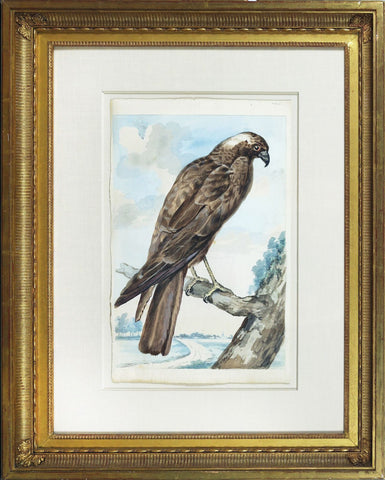![James Bolton (British, 1735-1799), “Fringilla montifringilla” [Brambling or Mountain Finch]](http://aradergalleries.com/cdn/shop/products/bolton_FringillamontifringillaBramblingorMountainFinch_large.jpg?v=1605205057)
James Bolton (British, 1735-1799), “Fringilla montifringilla” [Brambling or Mountain Finch]
James Bolton (British, 1735-1799)
“Fringilla montifringilla” [Brambling or Mountain Finch]
Original watercolor for Harmonia ruralis; or, An Essay towards a Natural History of British Song
Birds (published in Stannary, near Halifax [Yorks.]: for the author, 1794-1796.)
Signed and dated, 1782
Paper size: 9 x 11 1/4 in
Frame size 20 1/8 x 17 1/4 in
References: Nissen IVB 115; Zimmer p. 64; Wood p. 247; Mengel 310
James Bolton was born near Yorkshire in 1735, the son of William Bolton, a weaver. James initially followed his father's trade, but later became a self-taught art teacher and finally a tavern owner in Warley's home village. James and his older brother, Thomas Bolton (1722–1778), were keen naturalists. They both contributed to the natural history section in The History and Antiquities of the Parish of Halifax in Yorkshire, published in 1775 by John Watson.
James Bolton subsequently developed his interest by writing and illustrating several important natural history books, including Richard Relhan's Flora Cantabrigiensis (1785), his Filices Britannicae (1785), and his three-volume work, A History of Fungusses Growing About Halifax (1788-1790).
Bolton's final published work was Harmonia ruralis, an "essay towards a natural history of British songbirds," issued in two volumes (1794–6). Birds and their nests were drawn from life, while the text contained many of Bolton's first-hand observations. The popularity of the subject matter led to two subsequent but posthumous editions in 1830 and 1845.
Bolton executed this watercolor to prepare his Harmonia ruralis, perhaps the most ornate and luxurious work on the eighteenth-century British songbirds. It was considered a standard treatise by many ornithological experts. Eleazar Albin had dealt with the same group in his Natural History of English Song Birds of 1737, but his interest focused mainly on catching and training singing birds suitable to be kept in cages. Bolton aimed to improve on Albin's book by giving accurate pictures of both sexes of each species and their nest and eggs. Bolton described every part of the bird, from the tip of its beak to the end of its tail, carefully noting any distinctive marks in plumage. He brilliantly combines meticulous attention to scientific detail with the charm and animation of his birds.
An exhibition devoted to James Bolton and his works was held at the Liverpool Museum in 1995-6, and he was one of the artists featured in the Nature Observed show at the University of London in 2006.
or by email at loricohen@aradergalleries.
We Also Recommend





